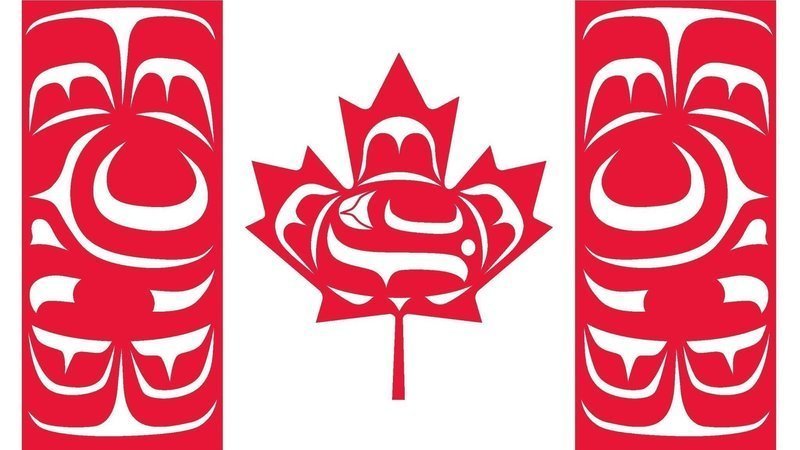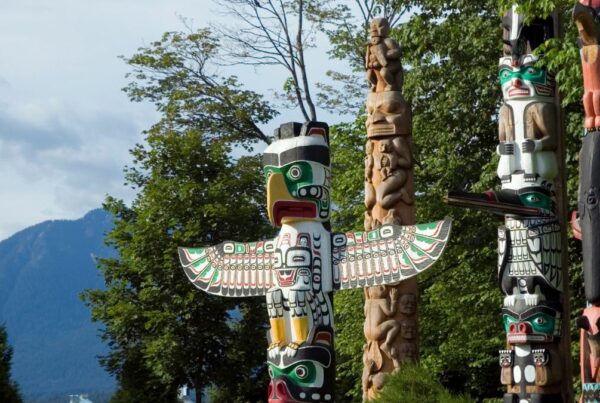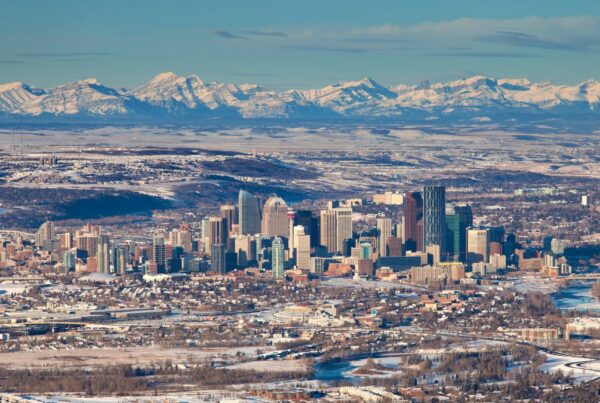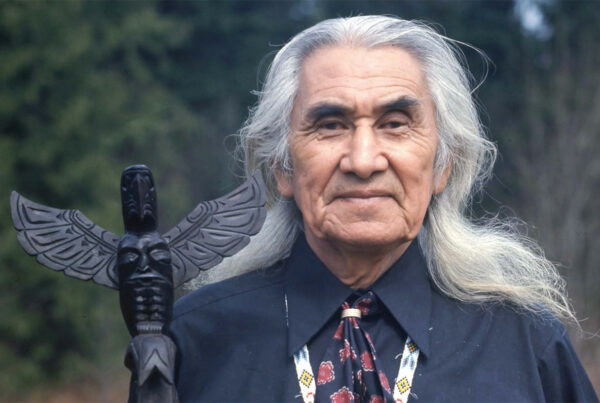Canada has nearly 350,000 official place names, with about 8% of those names having some sort of Indigenous or First Nations origins.
I believe it is an important part of reconciliation for the return of some Indigenous First Nations names for important landmarks (and to educate people about Indigenous words they use regularly — often without knowing it).
I also wanted to include the Canadian Indigenous Flag in the header, which was designed by Kwakwaka’wakw artist Curtis Wilson to create a new flag to represent First Nations in Canada.
The two designs on the red side bands are K’utala-Salmon, which convey the importance of family, friendships, and strength in numbers. The design within the maple leaf is a head of a killer whale in the shape of an oval.
Stories from the Land: Indigenous Place Names in Canada
In 2019, the Geographical Names Board of Canada, a national body comprised of representatives of all provinces and territories and federal departments and agencies, developed Stories from the Land: Indigenous Place Names in Canada, an interactive digital map of Canadian place names of Indigenous origin.
I highly recommend browsing the interactive map to learn some of the Indigenous place names where you live in Canada.
I have also put together some of the original Indigenous First Nations names for the lands where many popular towns, cities, geographic features and places are found across Canada with a particular focus on the Western Canadian provinces of Alberta and British Columbia:
National Parks and Provincial Parks:
Here are the origins of some important national and provincial park names in Canada:
Yoho National Park is named after a Cree word for ‘awe’ or ‘wonder.’
Kootenay National Park is derived from the proper name of the Kootenay people, the Ktunaxa.
Kananaskis is derived from Cree story about “Kin-e-a-kis” (the word translates as “the one who is grateful”), a native warrior who survived after receiving a devastating blow to the head with an axe in a fight over a woman at the confluence of the Bow and Kananaskis Rivers that told to early explorer John Palliser.
Ozada is the name the local Stoney Nakoda calls the Kananaskis area, which means the “meeting of the waters” in the Stoney Language.
Algonquin comes from a First Nations word that means “At the place of spearing fishes and eels”, which originates from the Algonquin First Nation, part of the greater Algonquian group of tribes.
The Valley of Ten Peaks behind Moraine Lake in Banff National Park includes these four peaks named after the numerals of the Stoney language: Mount Tonsa (no. 4), Mount Tuzo (no. 7), Neptuak Mountain (no. 9) and Wenkchemna Peak (no. 10).
Rivers, Lakes And Waterfalls
Athabasca is a prominent word which names a river, waterfall, lake and mountain in Jasper National Park meaning “Where there are reeds” in Cree.
The Bow River comes from the Blackfoot name for the river Makhabn, “river where bow reeds grow” as the reeds there were good for making bows with which to shoot arrows.
Saskatchewan comes from the Cree name for the North and South Saskatchewan Rivers Kisiskatchewanisipi, meaning “swift flowing river”.
Lake Erie is derived from “erielhonan” which is Iroquoian for “long tail.”
Lake Huron was named after the Huron First Nations communities that inhabited the region (also called Wyandot or Wendat).
City Streets
Deerfoot Trail in the city of Calgary is named in honour of Deerfoot-Bad Meat, a Siksika Blackfoot man who was an exceptional long-distance runner working as a messenger for the Blackfoot Confederacy running between camps in the North West Territories and the Montana Territory.
Crowfoot Crossing is named after Chief Crowfoot (1836 – 1890) who was the chief of the Siksika First Nation and played an instrumental role in the Treaty 7 negotiations as a representative of his people.
City Names
Toronto originates from the Mohawk word “Tkaronto,” meaning “the place in the water where the trees are standing.” It is said to refer to the wooden stakes that were used as fishing weirs in the narrows of local river systems by the Haudenosaunee and Huron-Wendat.
Ottawa comes from the Algonquin word adawe, meaning “to trade”.
Calgary is named after Calgary Bay in Scotland. The Scottish name is derived from the Gaelic words Cala-ghearridh meaning pasture by the bay. The Siksika called the place that is present-day Calgary “moh-kíns-tsis,” meaning “elbow.” According to records from 1875, they expanded the name to “moh-kíns-tsis-aká-piyoyis,” which means “elbow many houses.” The Stoney Nakoda called it “wincheesh-pah,” the Cree referred to it as “otos-kwunee,” and the T’suu T’ina named the area “kootsisáw” — all of which mean “elbow.”
Medicine Hat is a translation of the Blackfoot word Saamis, meaning “headdress of a medicine man”.
Coquitlam is derived from the name of the Kwikwetlem people and means “small red salmon” in Upriver Halkomelem language.
Kamloops comes from the Shuswap word Tk’emlups, meaning “where the rivers meet”.
Chilliwack comes from the Halqemeylem language, and means ‘going back up.’ It can also mean ‘quieter water on the head’ or ‘travel by way of a backwater of slough.’
Kelowna comes from the Okanagan language, and it means male grizzly bear.
Penticton is from the Okanagan language and it roughly translates into “place to stay forever.”
Squamish means “mother of the wind,” due to the nature of the strong winds present in the Howe Sound area in the language of the Skwxwú7mesh (pronounced Squ-HO-o-meesh) or ‘the Squamish People.’
Tsawwassen comes from the North Straits Salish meaning “looking towards the sea.”
Region Names
Canada comes from the Saint-Lawrence Iroquoian word Kanata meaning “the village”. This tribal group are believed to have disappeared because of late 16th-century warfare by the Mohawk nation of the Haudenosaunee or Iroquois League, which wanted to control trade with Europeans in the valley.
Alberta is not an indigenous name. It was named for Queen Victoria’s fourth daughter, Princess Louise Caroline Alberta. Lake Louise is also named after her. The Princess was the wife of the Marquess of Lorne, who was Governor General of Canada in 1882 when the District of Alberta was created as part of the Northwest Territories.
Manitoba likely comes from the Cree “Man-into-wahpaow”, which means “the narrows of the Great Spirit”. The words describe Lake Manitoba, which narrows to half a mile at its centre.
Nunavut means “our land” in Inuktitut, the Inuit language. On April 1, 1999, Canada created a third territory called Nunavut from existing Northwest Territories land. Inuit make up almost 85 percent of Nunavut’s population.
Quebec comes from the Míkmaq word Kepék which means “the place where the river narrows”. This refers to the St. Lawrence River, which connects all five of the Great Lakes to the Atlantic Ocean.
Ontario comes the Iroquois word onitariio or kanadario meaning “land of shining waters”.
The Yukon comes from a contraction of the words in the Gwich’in phrase chųų gąįį han, which means “white water river” and refers to “the pale colour” of glacial runoff in the Yukon River.
Haida Gwaii is an archipelago that was previously called the Queen Charlotte Islands is the traditional territory of the Haida people, and in their language it means “the islands of the people.”
I hope you found this list of indigenous place names in Canada illuminates. If you have any suggestions to add please feel free to email me.
- Chephren Lake And The Mistaya River Valley - July 1, 2024
- Mindfulness And The 4 Steps of Attention Restoration Theory - June 29, 2024
- 3 Pillars Of An Ecotourism Marketing Strategy For Selling Travel Experiences - June 29, 2024



